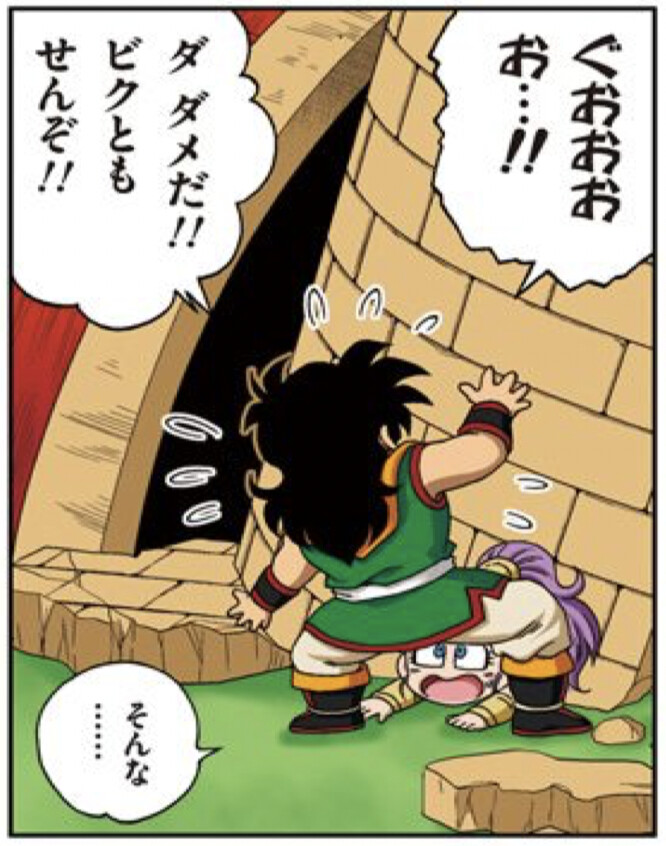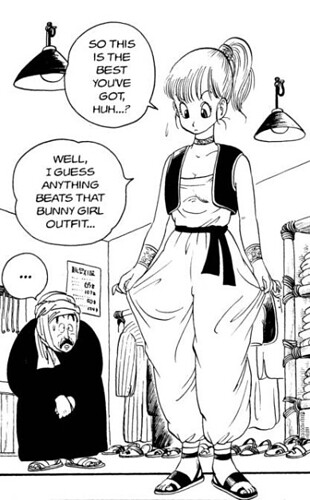I haven’t read the chapter yet, but at least this mystery I can solve: ハナクソ, not ハナクン. It means ‘snot’. I found a whole article about this pun!
Interesting article, thanks for finding that. I like how in the original version the pun is spelt out more obviously with the dots next to はなくそ. I still don’t understand how the second half of the sentence breaks down, but happy to accept that it’s a pun I don’t fully get!

We were overcomplicating it lol. I asked on Hinative and the joke is that it would’ve been 話そう originally, but they added the く to make to the same as ハナクソ. So there is no such thing as a 〜くそう grammar point or something ![]()
I was about to start reading and I noticed I missed the gag from the previous chapter:
It’s a reference to a rather bawdy part of the story that is understandably left out in this children’s version (but that has sure made me think I should read the original Dragon Ball as well! ![]() ).
).
I now know who this guy is. In the original manga Oolong transforms into this dapper gentleman character while Goku is disguised as a girl. In the SD version he transforms into Zarbon instead, which is why this guy is there at the end of the chapter bemoaning that the kids of today don’t appreciate his elegant looks.

I was reading the original manga this morning and found that Yamcha is actually fine around Chi-Chi. In fact when Puar expresses surprise that his fear of girls didn’t bother him around Chi-Chi, Yamcha’s response is: That child?! Do you think I’m some kind of pervert?
So I agree, I think the reason he collapses is an in-joke relating to future events between Yamcha and Saibamen.
After your insightful posts I was considering doing the same. How condensed is the SD-version compared to the original, would you say?
I’d say it is pretty condensed… about 2.5 volumes of the original per volume of the SD (or at least for the beginning chapters). I’ve been reading it in parallel and there are quite a few “inside jokes” in SD.
I am reading the original in English though, which is available at the Viz subscription services for about $1.99/month. It also includes all the manga from Shonen Jump coming out currently.
Me too, this is such great value for money. I read the whole lot (from 1984 up to present day Dragon Ball Super) over a year or so finishing early this year. But I hadn’t realised how much of the early years I’d forgotten. I’m definitely enjoying reading them again, as well as spotting the differences in the story line (e.g. in the original the House Wagon belongs to Oolong, not Chi-Chi, and Chi-Chi doesn’t appear until they are on their way to Fire Mountain. It’s Yamcha that she first meets running away from the dinosaur, not Goku).
The original is definitely a lot ruder than the SD version!
I’ve read the early years 15ish years ago, so I had forgotten almost everything…
I also forgotten how crude and hilarious some of the humor is… like… Bulma exposing herself, or Master Kame being way more perverted than I remembered
Overall, worth re-reading.
And not even a little either. Boy, what gusto!
To go off on a bit of a tangent… I noticed that Master Roshi is wearing a shirt with letters on it in the original, and they seem a bit… off?
I noticed something similar in Shinchan, random lettering on fabric:


Is this a thing in manga…? Is there a specific reason for it?
Not sure about meaning. Perhaps just an artistic style that has then been copied by other artists? I like that the letters change from one panel to the next:
Summary


Another thing I spotted today, it’s not very clear in the SD version why they take Oolong with them on their journey. Goku asks Bulma that exact question in the original:
Summary


As for the chapters: chapter 4 in the SD version takes us to the end of chapter 15 in the original, and chapter 5 in the SD version takes us to midway through chapter 20 in the original.
In between we’ve missed out the whole of the encounter with the rabbit mob, which incidentally is where Bulma got the rather Arabic looking outfit she’s been wearing recently in our version:
Yay! I finally caught up with Chapter 5 and will be able to join tomorrow starting with Chapter 6.
I also added some new vocabulary to chapters 4 and 5
And I found this funny Easter egg in one of the pages
I didn’t recognise the red books on the top shelf?
Week 10! 
Start date: 2 Jan
Pages: 105-124
- I am reading along

- I am catching up

- I am dropping this book

0 voters
Surely only in Japan is it considered appropriate to have a full frontal view of a naked male 14 year old in a comic strip! This was seen in chapter one of the original but I assumed they were deliberately leaving it out for this younger children’s version - I was wrong!
Yeah no. That is a distinctly American opinion. Most other cultures really do not have body hangups like Americans do.
Page 116

ビクともせんぞ was giving me trouble. What is ビク?
Page 121
I am not sure what to do with うえに here. DeepL gives me ‘that’s very specific and very long’ for this sentence, which seems to fit in quite well, but how did it get to that translation…?
As for naked kids… When reading Shinchan I was surprised to see full frontal nudity, because the Shinchan cartoons I saw on Dutch television as a kid definitely did not feature any penises. We’re a lot more relaxed about nudity in the Netherlands than in the States (e.g. nude beaches, occasional nudity on mainstream television), but portrayals of child nudity are a big no no.
It’s strange how something can be so shocking in one culture and so normal in another. I remember seeing a poster on the wall in an onsen changing room which had photos of three boys around 10 years of age fully naked.
やけに具体的な上に長いわね…
I read this as: As well as/on top of being awfully specific, that was long…
I couldn’t find it in Jisho when I was reading, but found a JLPT Sensei reference now.
I think this is びくともしない - jisho link. Presumably せん is a contraction of しません.
I remember once looking up movie ratings in Western Europe vs. USA.
It went something like this…
- pretty mild movie, but there’s a scene with a nip slip - Europe (all ages), USA (mature)
- Wars and fights and stuff - Europe (13+), USA (all ages)
- More war, gore and blood - Europe 17+, USA (13+)
So basically, in the USA it’s ok to have lots of violence, as long as nobody shows their boobs.
I agree with Phryne comments on うえに it means besides/in addition to. I added to the sheet.
I also learned a new grammar on page 108:
For the じゃあるまし ーLink here
Does anyone know what the following means?:
"ぽげぎゃー” (page 111). Just a generic scream?
"むにゅむにゅ” (page 121, bottom left)




